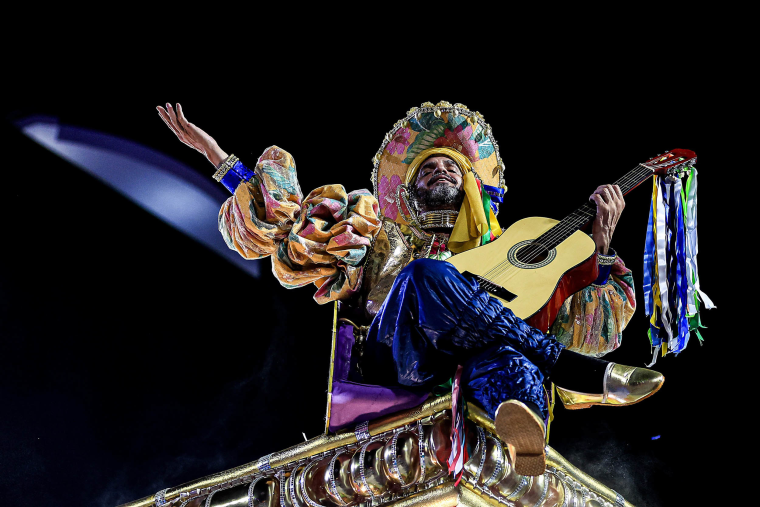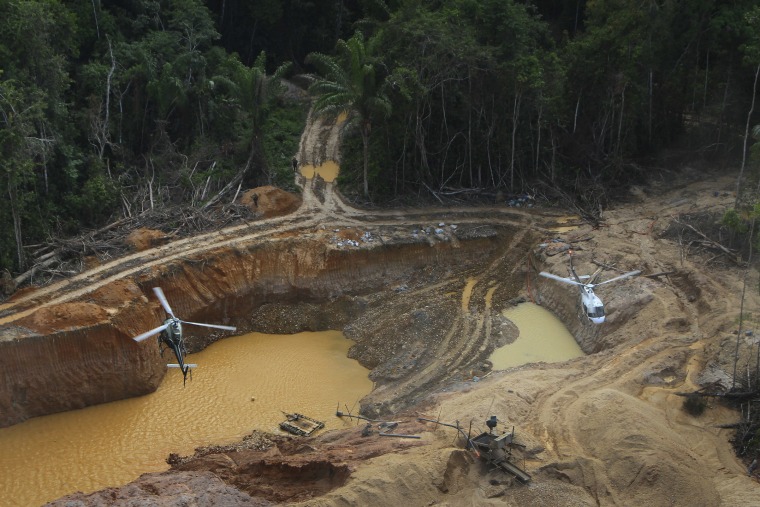Rio’s Carnival parade makes plea to stop illegal mining in Brazil’s Indigenous
RIO DE JANEIRO — Carnival dancers took the biggest stage in Rio de Janeiro on Sunday night with their faces painted red in a traditional Indigenous manner, while percussionists had “Miners out” written across the skins of their drums.
It was part of Salgueiro samba school’s tribute to the Yanomami, Brazil’s largest Indigenous group, with its giant floats, costumes and songs based on the group’s ancient culture and traditions.
“My Salgueiro is the arrow for the people of the forest,” the parade participants sang out as they marched through the Sambadrome, delivering their message to more than 70,000 revelers at the Sambadrome and millions watching live on television. “The chance that’s left for us is an Indigenous Brazil.”

President Luiz Inácio Lula da Silva is under pressure to deliver on promises to eradicate illegal mining, particularly amid a recent backslide in efforts. Sunday’s parade comes as Brazil celebrates one year since Lula declared a public health emergency for the Yanomami people in the Amazon, who are suffering from malnutrition and diseases such as malaria as a consequence of illegal mining.
“Ours is a cry for help from Brazil and the world in general,” said Davi Kopenawa, a Yanomami leader and shaman who advised the samba school on how to remain truthful to his people, and paraded with Salgueiro. “My hope is that the world, upon hearing our call, will put pressure on the Brazilian government to remove all the miners, destroyers of our mother Earth, who are soiling the water and killing fish.”
Kopenawa paraded with feathered armbands and headdress, plus a beaded necklace depicting a jaguar. He was joined by 13 other Yanomami who flew across the country to participate in Salgueiro’s parade. One of the first floats consisted of a severed tree trunk, with a performer depicting a Yanomami mother seeking to protect her child as invaders drew close, and other floats featured massive sculptures of Yanomami people.
Through this homage to Yanomami history and culture, Salgueiro sought to draw attention to the devastating effects brought by illegal mining inside Yanomami territory, including widespread river contamination, famine and disease.
Some 30,000 Yanomami live in Brazil’s largest Indigenous territory, spanning more than 9 million hectares (22 million acres) in the northern area of the Amazon rainforest, along the border with Venezuela.

Three weeks after assuming the presidency, Lula declared a public health emergency and sent the armed forces, doctors, nurses and food. Still, over 300 Yanomami died of various causes in 2023, according to the health ministry.
Lula swiftly created a dedicated inter-ministerial task force to fight illegal mining and in 2023, Brazil’s environmental agency destroyed a record 33 aircraft found on or near Yanomami territory. The agents also wrecked or apprehended mining barges, fuel, chainsaws, Starlink internet units and campsites. Government officials say that since the beginning of the operation, areas with illegal mining inside Yanomami territory have dropped 85% and that Yanomamis’ health has improved.
But after the operation’s initial success, prosecutors, law enforcement and employees of federal environmental agencies say illegal miners are returning.
“There has been a significant reduction, but mining hasn’t ended. We reckon that the miners are exploiting as much as possible, because they assess they eventually will have to leave,” Jair Schmitt, head of environmental protection at Brazil’s environmental agency Ibama, told The Associated Press.
Schmitt said miners have adapted to escape law enforcement and satellite detection by working at night, setting camp under the forest canopy and choosing old mining pits instead of clearing forest to open new ones.

Humberto Freire, director of the newly created Amazon and environmental unit of the federal police, said officers also noticed miners have begun working in a much smaller, artisanal way, and that government agencies need to take stronger action.
“We need, for example, the air force to effectively control the airspace over Yanomami land. We need the navy to control the flow of people on rivers. We need the army to do a quality job, too,” Freire said. “The federal police can do more, the armed forces can do more, as well as Ibama and Funai (the Indigenous affairs agency.)”
One of the parade’s wings…
Read More: Rio’s Carnival parade makes plea to stop illegal mining in Brazil’s Indigenous

